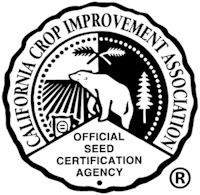GENERAL STANDARDS -- The standards on this sheet are in part condensed and apply to celery. For greater detail and additional provisions, see the General Standards.
APPLICATION -- Applications should be submitted electronically on CCIA’s website (Application to grow and certify seed) as soon as possible and no later than three (3) weeks after planting. New applicants should contact the CCIA office for instructions on obtaining access to the online application system.
FIELD HISTORY -- Land must not have grown or been seeded to any crop in the same genus during the years listed in the field standards table.
ISOLATION -- Fields or portions of fields producing seed must be isolated by the distance listed in the field standards table.
FIELD INSPECTION -- Each field intended for certification must be inspected prior to harvest. At least one inspection shall be made preferably during the mid-bloom stage and, in some cases, earlier and later inspections may be made.
Off-Types -- Every field should be rogued to remove any plants of another crop or variety, including volunteers. Native seed selections cannot always be differentiated at field inspection. When differences can be distinguished, the maximum mixture of other varieties, off-types, established volunteers, and inseparable other species or crops may not exceed the amount listed in the field standards table.
Weeds --Fields must be free of any prohibited noxious weeds. Restricted noxious weeds, and common weeds difficult to separate must be controlled. Prohibited and Restricted noxious weeds are listed in the California Seed Law/CA Code of Regulations/Sections 3854 and 3855. See California Seed Law - Prohibited and Restricted Noxious Weed List. Fields may be refused certification due to unsatisfactory appearance caused by weeds, poor growth, poor stand, disease, insect damage, and any other condition which prevents accurate inspection or creates doubt as to identity of the variety.
Scientific Name | Common Name | Field History/Years | Isolation/ft. | Off Types/ratio | ||||||
| Digitaria californica | Arizona Cottontop | 3 | 2 | 1 | <5 Acres 900 | 450 | 330 | 1:1,000 | 1:500 | 1:250 |
| Sporobolus airoides | Alkali Sacaton | 3 | 2 | 1 | <5 Acres 900 | 450 | 330 | 1:1,000 | 1:500 | 1:250 |
| Sporobolus contractus | Spike Dropseed | 3 | 2 | 1 | <5 Acres 900 | 450 | 330 | 1:1,000 | 1:500 | 1:250 |
| Sporobolus wrightii | Giant Sacaton | 3 | 2 | 1 | <5 Acres 900 | 450 | 330 | 1:1,000 | 1:500 | 1:250 |
HARVESTING --Harvest is subject to the supervision of the County Agricultural Commissioner who must be contacted prior to harvest. Any seed moved out of the county for conditioning must be accompanied by an Intercounty Permit or Interstate Transfer issued by the Commissioner.
CONDITIONING AND SAMPLING -- Conditioning of seed for certification may be done only in facilities approved for this purpose by the California Crop Improvement Association. It is the responsibility of the applicant to determine if the plant is eligible before delivering seed for conditioning. Conditioning, sampling, reconditioning, and blending must be supervised by the County Agricultural Commissioner. Conditioning equipment must be free from contaminating seed to the satisfaction of the supervising inspector.
SEED INSPECTION - All seed must be sampled and tested after conditioning and the seed lot must meet or exceed seed certification standards for that crop. A seed lab using the Association of Official Seed Analyst “Rules for Testing” must test the sample. A Registered Seed Technologist must sign each lab analysis. In addition to AOSA rules, specific seed testing may be required to meet CCIA seed certification standards.
The conditioner is required to submit a weight equivalent to 25,000 seeds to the laboratory for a purity, germination, and noxious examination. When available, specific weight of different species can be found here: (Submitted Sample Sizes for Certification). In some instances, varietal identity cannot be determined by visual seed inspections. Seed must be well screened and graded, bright in color, of good appearance and meet the following standards:
Scientific Name | Pure Seed (Minimum) | Inert Matter (Maximum) | Total Other Crop Seed (Maximum) | Weed Seed* (Maximum) | Germination (minimum) | Off-types (same species) | ||||||||||||
| Digitaria californica | 50% | 50% | 50% | 50% | 50% | 50% | 0.15% | 0.15% | 0.15% | 0.15% | 0.15% | 0.15% | 70% | 70% | 70% | 0.10% | 0.20% | 0.40% |
| Sporobolus airoides | 80% | 80% | 80% | 20% | 20% | 20% | 0.15% | 0.15% | 0.15% | 0.15% | 0.15% | 0.15% | 70% | 70% | 70% | 0.10% | 0.20% | 0.40% |
| Sporobolus contractus | 85% | 85% | 85% | 15% | 15% | 15% | 0.15% | 0.15% | 0.15% | 0.15% | 0.15% | 0.15% | 70% | 70% | 70% | 0.10% | 0.20% | 0.40% |
| Sporobolus wrightii | 80% | 80% | 80% | 20% | 20% | 20% | 0.15% | 0.15% | 0.15% | 0.15% | 0.15% | 0.15% | 70% | 70% | 70% | 0.10% | 0.20% | 0.40% |
*Zero tolerance for noxious weed seeds.
Updated October 2025
